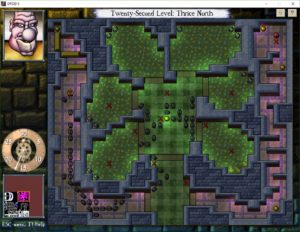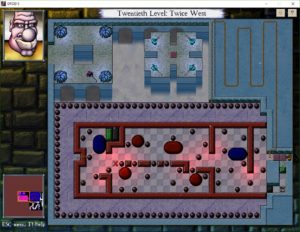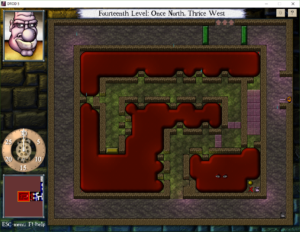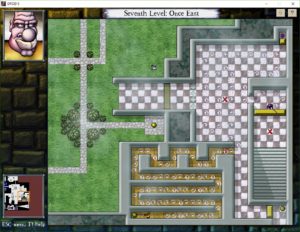JtRH: Smart, but Not Smart Enough
And now I want to describe another hidden room with a Challenge. This one is on level 22, and my experience of it is pretty much the exact opposite of the one on level 20.
 The theme of level 22 is something I mentioned recently: rooms that you can’t solve on first visit, although with an added emphasis on exposing the player to monsters on the first pass. Perhaps the pinnacle of this theme is 2N2W (that is, the room two rooms north and two rooms west of the entrance). This room has six blobby chambers arranged like flower petals, each containing at least two immobilized roach queens — enough to spawn roaches faster than Beethro can kill them — plus a passage on either side containing a Brain to make sure you can’t escape the roaches. As a hint to the player, Beethro says to Halph on initially entering the room from the south that he won’t be able to kill everything and that they should just get the doors to the west open and run for it. (This is most easily accomplished by just standing by the doors and fending off roaches while Halph runs around the other side of the room hitting the orbs that open them.) The western passage circles around through four other rooms and lets you re-enter the room from the north, where there’s a little isolated nook containing a fuse that ignites the bombs in the roach chambers.
The theme of level 22 is something I mentioned recently: rooms that you can’t solve on first visit, although with an added emphasis on exposing the player to monsters on the first pass. Perhaps the pinnacle of this theme is 2N2W (that is, the room two rooms north and two rooms west of the entrance). This room has six blobby chambers arranged like flower petals, each containing at least two immobilized roach queens — enough to spawn roaches faster than Beethro can kill them — plus a passage on either side containing a Brain to make sure you can’t escape the roaches. As a hint to the player, Beethro says to Halph on initially entering the room from the south that he won’t be able to kill everything and that they should just get the doors to the west open and run for it. (This is most easily accomplished by just standing by the doors and fending off roaches while Halph runs around the other side of the room hitting the orbs that open them.) The western passage circles around through four other rooms and lets you re-enter the room from the north, where there’s a little isolated nook containing a fuse that ignites the bombs in the roach chambers.
 I describe that room in particular because the hidden room I want to describe, 3N, is a variation on it. It lacks the bombs, but it also changes the walls and the roach placement in small ways that, per Beethro’s assessment, make the room solvable without them. The conventional solution starts the same as in the original version, escaping to the west. This just takes you to a dead end in a different room — a room, in fact, that you’ve already visited by this point. The visible but inaccessible dead end is a clue to the existence of the hidden room. The point of visiting the dead end is that the room resets when you re-enter it from the west, granting you enough time to kill the Brain in that passage and then dash over to the eastern passage to kill the other one before the room gets too roachlogged to make that run. You still have massive amounts of roaches to deal with afterward, and getting past the first two chambers is difficult and time-consuming. But at least you get to engage the roaches on your terms, once the Brains are gone.
I describe that room in particular because the hidden room I want to describe, 3N, is a variation on it. It lacks the bombs, but it also changes the walls and the roach placement in small ways that, per Beethro’s assessment, make the room solvable without them. The conventional solution starts the same as in the original version, escaping to the west. This just takes you to a dead end in a different room — a room, in fact, that you’ve already visited by this point. The visible but inaccessible dead end is a clue to the existence of the hidden room. The point of visiting the dead end is that the room resets when you re-enter it from the west, granting you enough time to kill the Brain in that passage and then dash over to the eastern passage to kill the other one before the room gets too roachlogged to make that run. You still have massive amounts of roaches to deal with afterward, and getting past the first two chambers is difficult and time-consuming. But at least you get to engage the roaches on your terms, once the Brains are gone.
The Challenge scroll for the room is in the dead end to the west, and the Challenge is to complete the room without using the dead end. This is honestly not much different than doing it the normal way. My solution: First I ran into the southeast lobe of the flower and killed the queens there. That took enough time for the roaches to get perilously close, so I retreated to the western passage and killed the Brain there. Getting from there to the eastern passage took some time, and judicious use of Halph. I had reduced the roach spawn count to 28 every 30 turns, so I basically got to move forward just two squares every 30-turn cycle. It wasn’t steady progress — turning the corner from south to east was tricky — but once I was in the eastern passage, it was basically the normal solution from there on. That is to say, the most difficult part of the puzzle was still ahead of me at that point, the part that dominates the experience of the room and which is completely unaffected by the Challenge.
The thing that really gets me, the reason I call it the opposite of that other Challenge, is that the Challenge solution is less clever than the normal solution. I mean, I’m not at all sure I would have thought of using the dead end if the Challenge scroll hadn’t told me not to. Sure, it fits the level’s theme better, but as it was, the only reason I went to the dead end before completing the room was that I wanted to read the Challenge scroll. The Steam Achievement for completing this Challenge is “Smart, but Not Smart Enough”. It could be describing me.
 Comments(1)
Comments(1)

